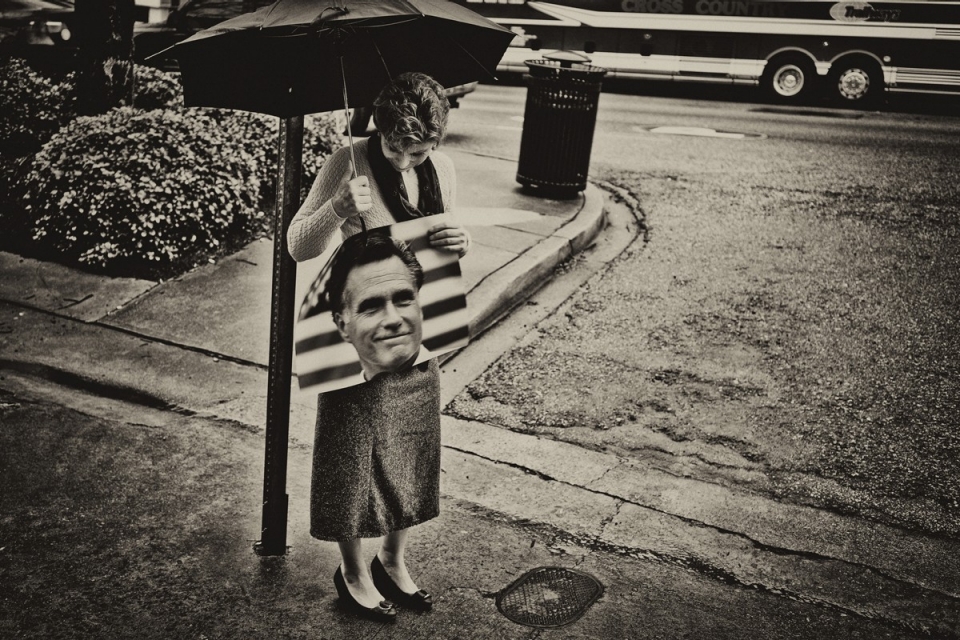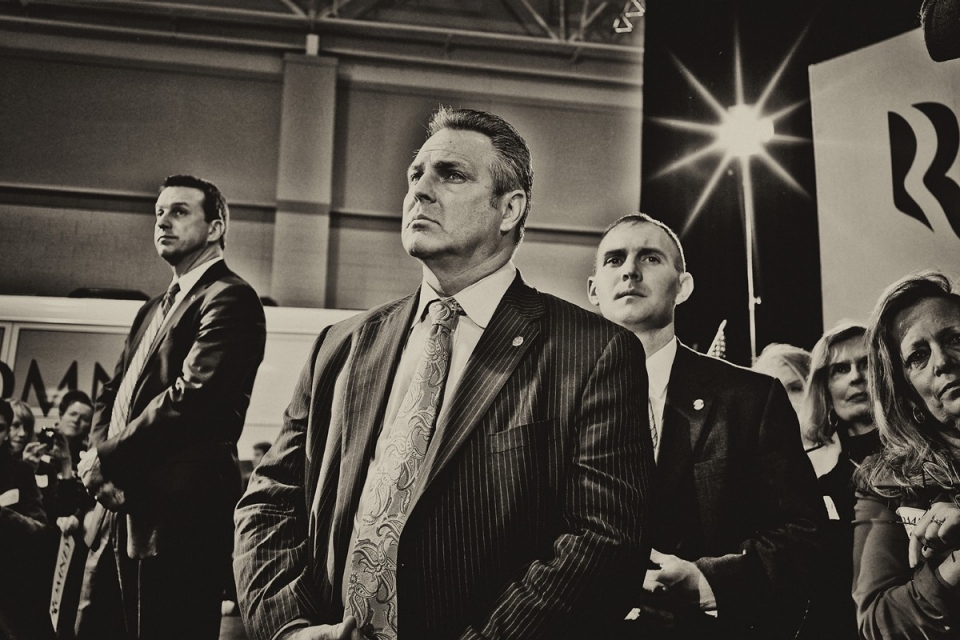Color photography has become so ubiquitous and so useful that I now am skeptical when a photojournalist resorts to black and white. Color no longer is the medium of advertising alone, nor is black and white the medium of documentary truth. You might say that we’ve learned to think with a color palette, and if a photograph is given a retro look, we risk losing information on behalf of artistic pretension, or assuming documentary truth that hasn’t been earned, or succumbing to nostalgia rather than learning something about the present. To see what still can be accomplished, however, take a a look at a recent series by Charles Ommanney on the Republican primary campaign in South Carolina.
Substitute George Romney for his son Mitt, and this photo from Greenville could have been taken in the 1960s. Perhaps there have been changes in public trash bin design, or in bus wheels, but otherwise her clothing, hair, and everything else in the picture could be built for time travel. She may be wearing contacts, of course, and may have a much better job than would have been available to a woman fifty years ago, but I find it striking that so little seems to have changed in half a century.
And that, I believe, is a very important implication of Ommanney’s artistic choice to use black and white. You’ll have to see the rest of the show at Newsweek/The Daily Beast, but I’m confident that many viewers will see what I see. Other than a few very small details such as the occasional smart phone, the photos suggest that nothing has changed: ordinary citizens of a homogenous society listen to a wealthy, good looking candidate campaign in a one-party state. The election rituals include flags, banners, signs, funny hats, and public speaking as the candidate presses the flesh and otherwise shows that he’s a man of the people. The people don’t look too well off, but they’re proud, and the campaign is exciting but still a relatively humble, egalitarian process.
Of course, that process is run by men–and men who mean business. And that is just one part of how there is something creepy, even downright ugly about the photographs, as you can begin to see with this shot from North Charleston. This is not a welcoming image, but rather something much closer to a portrait of white resistance. The photographs are astonishingly homogenous, and it becomes clear that the world of the Republican primary is a black and white world–and the primary process one that is for whites only.
Whatever his intentions, Ommanney has brilliantly captured how the GOP is trying with all its might to turn back the clock. Against the reality of a multiracial, multicultural, pluralistic civil society and an African-American president, they want to make the present look as much as possible like the past. That past ideal may be the ruinous economic policies of the last Bush presidency or the vicious social order recently illustrated in The Help, but it’s always a past that most Americans today want to leave far behind. Indeed, we can look to a photograph form another primary campaign in South Carolina to see just what a difference there is between the new America and the old.
Ommanney’s images do more as well. There can be some reassurance in the thought that politics may have changed less than many pundits suppose. Of course, the South is now a Republican stronghold rather than Democrat, the primary campaigns probably are financed more than ever before by a small number of wealthy donors, the media saturation is complete, and the struggle for the soul of the nation is as difficult as ever, but the process still is democratic, demanding, unpredictable, and revealing. History may be more than a reactionary political vision or an artistic device, but rather something that is being lived and moved forward, however slowly and painfully, year by year, day by day.


The images are great. Yes, you could replace Romney the Younger with Romney the Elder and the story of the the electoral process remains the the same. However, it also strikes me that the series also points out the direction in time that the featured candidate and his party want to take the country… back to the middle of our previous century.
[…] blogs, No Caption Necessary: Iconic Photographs, Public Culture, and Liberal Democracy, posted this discussion of photos take at the South Carolina Republican Primary in response to a Daily Beast photoessay that covered the Primary using black and white images. In […]